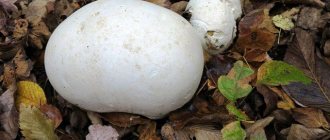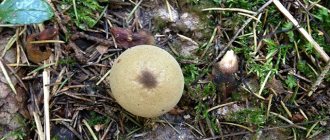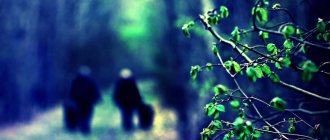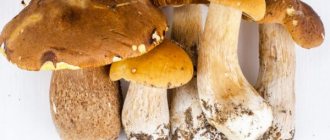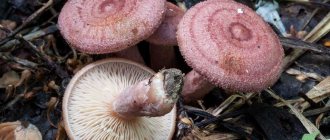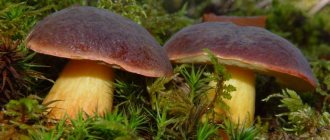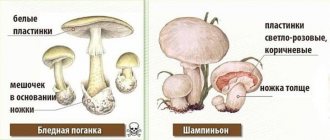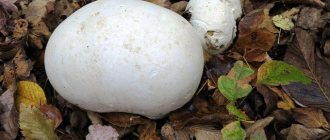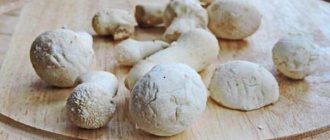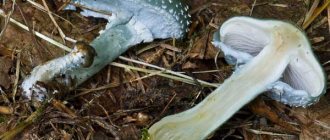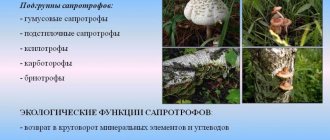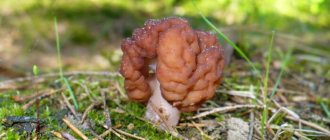Description and photo of the raincoat
Puffball is a rather unpretentious mushroom that is rarely confused with other species. It has a unique structure that stands out from other forest fruits.
What does a mushroom look like?
The raincoat can be round, ovoid or pear-shaped. Depending on the species, the mushroom differs in size and weight. Lovers of forest walks often find fruits that weigh from a few grams to 2 kilograms.
The outer shell has a white, grayish-white or yellow tone. In some varieties, warts or spines are clearly visible that cover the surface of the cap.
a brief description of
Raincoats are not in great demand among mushroom pickers, but in vain, since they are meaty and have beneficial properties.
Is the puffball mushroom edible?
This variety of mushroom is edible. The exception is two types - false raincoat and hedgehog raincoat. During cooking, only young mushrooms that have retained the white color of the pulp can be used.
In a mature puffball, the cut flesh gradually darkens to an olive-brown or brown hue.
Mushroom category
According to nutritional properties and taste, edible mushrooms are divided into 4 categories. The most delicious and common mushrooms in cooking belong to the 1st category. Puffballs are low-value mushrooms of the 4th group, which are inferior in taste to other types and are not so often used in recipes. However, in terms of protein content, they are superior to the commonly used porcini mushrooms.
Where and how does it grow?
Puffballs mainly grow in coniferous forests, as well as mixed forests, gardens and meadows. They germinate in groups, rarely found alone. You can find mushrooms in clearings, forest edges, and also in fields. © https://ydoo.info/product/griby-dozhdeviki.html Pear-shaped puffball can grow on the rotting bark of deciduous trees.
They grow from mid-summer to October. However, in warmer regions you can find these mushrooms in late May.
The puffball mushroom reproduces during the ripening period, when its upper body opens, from which spores are released. The spores spread through the forest with the help of the wind, and then germinate in new places.
What does it look like?
The puffball mushroom can be distinguished by its round or pear-shaped shape. A raincoat usually looks like a small closed sphere of snow-white color. The color of the mushroom depends on its type, so you can find white, brown and yellow puffballs. On the upper shell of the fruiting body there are tubercles that are covered with small spines.
Raincoats have no division into a cap and a stem; they are characterized by a closed body, similar to a light bulb, and sometimes to a ball. However, there are specimens with a pronounced false stalk (false because it is not a stalk, but an elongated shape of a mushroom, visually similar to a stalk, but in fact just part of the fruiting body).
The pulp is elastic and dense, white in color both outside and in the cut. As it matures, the color of the mushroom changes. At first the color turns yellow, and the surface gradually loses its elasticity and becomes flabby. At the very end of ripening, the mushroom is dark brown in color, and the surface of the fruiting body is dry.
The great thing about raincoats is that they explode. If you step on a mature mushroom, its body will burst with the characteristic sound of a small explosion, and dark brown spore powder will be sprayed around.
Mushroom dimensions
The body is pear-shaped or spherical in diameter and can stretch from 6 to 10 cm. The false leg reaches a length of up to 5 cm, and its diameter is approximately 2 cm.
Taste
Puffball mushrooms are characterized by a pleasant taste with light notes of hazelnut. The pulp is very tender, like marshmallow. The taste is somewhat similar to porcini mushrooms.
Smell
Young raincoat has a pleasant, subtle aroma. As it ripens, the smell changes to a more pungent one.
Is puffball edible and how can you eat it?
The mushroom is popular in cooking due to its dietary characteristics. Experienced housewives use a variety of techniques to provide their family with a healthy product for a long period.
Heat treatment
A raincoat can be prepared in several ways:
- Cooking. Pre-processed mushrooms are immersed in boiling water and cooked for at least 30 minutes. Water is taken in a ratio of 3 liters per 0.5 kg of raincoats. Salt and spices are added to taste. The result is a broth that can be used as a base for mushroom soup.
- Frying. Boil the mushrooms a little in water (3 minutes) so that they become soft. Then put it in a hot frying pan and fry for 7-10 minutes, add salt, pepper and other seasonings to taste.
Preparations for the winter
The following will help preserve the useful qualities of a raincoat for a long period:
- Pickling. Peeled and chopped mushrooms (1 kg) are boiled for 20 minutes. Then add salt (3 pinches), sugar (1 tbsp), pepper (6 pcs.), as well as cloves (2 sprigs), dill (2 tsp) and garlic (2 cloves). Boil all ingredients for no more than 10 minutes, pour in 4 tbsp. l. vinegar. The finished mixture is placed in jars and sent to a cold place.
- Freezing. The mushrooms are initially blanched by boiling in boiling water for 5-7 minutes. Then he puts the raincoats in a colander, allows the liquid to drain and fills with cold water. The water is drained from the cooled workpiece again, packaged in bags and sent to the freezer. Shelf life: no more than 8 months.
- Canning. The raw materials are cleaned, cut into pieces and soaked in a lemon-salt solution for 20 minutes. The mushrooms are drained in a colander, washed thoroughly, placed in a pan of cold water (1 kg per 5 l) and cooked for 20 minutes.
The marinade is prepared from thyme (3 branches), mustard (1 tsp), salt (1 tbsp), sugar (2 tsp), as well as black pepper (2 peas) and garlic (2 cloves) . All ingredients are boiled for 7 minutes, 100 ml of vinegar is poured in and left for another 3 minutes. Then the mushrooms are placed in jars, filled with brine and tightly closed with lids. - Salting. The procedure is carried out cold, after soaking the mushrooms in water. Raincoats are placed in layers in a container, sprinkling each of them with salt, in a ratio of 40 g per 1 kg of raw materials. Currant and oak leaves, horseradish, peppercorns and bay leaves are also added. All ingredients are covered with a flat plate, pressure is set and left for a month.
Useful properties and restrictions on use
A raincoat has a number of useful properties that most people are not even aware of. First and foremost is its ability to fight cancer cells thanks to the calvacin contained in its pulp. The substance actively resists bacteria and fungi, and also reduces the rate of growth of tumors.
Medicines containing puffball spores effectively remove heavy metals and toxins from the body. The mushroom pulp is suitable for external and internal use. It is applied to ulcers formed due to skin cancer.
Good to know!
Tinctures containing raincoat particles effectively cope with heat and inflammatory processes.
Preparations based on raincoat help improve the functioning of the gastrointestinal tract, normalize blood pressure, thin the blood and strengthen the immune system. Also, its spores cope with bleeding, have an analgesic effect and relieve purulent inflammation on the body.
There are a number of nuances that should be considered before using the mushroom:
- It is prohibited to use fruits collected near industrial production and highways. The raincoat quickly absorbs toxins that can harm your health.
- Pregnant and breastfeeding women should avoid using it.
- People suffering from kidney pathologies are strictly prohibited from taking raincoat-based medications.
- Another important factor is individual intolerance.
Where it grows and how to collect it
Raincoat is a very unpretentious fruit that is found everywhere. The only exception is Antarctica. The fungus does not react to the acidity level of the soil, so it can be seen in forests (coniferous and leafy), in clearings, meadows. It often grows directly in gardens, as well as along roads. The raincoat gets along well on manured soils.
It can almost always be found in pastures located near farms and stables. The mushroom appears after heavy rains, which is why it got its name. You should go “hunting” from mid-June until the end of September. In this case, young fruits should be collected, away from highways and factories.
Variety of species
Even an experienced mushroom picker does not always navigate the complex taxonomy. This applies to many mushrooms, including puffballs.
At first you call all the mushrooms “wolf tobacco”, then, having learned that these are puffballs, you will call them puffballs, and then you will understand that puffballs are different: just a puffball, a prickly puffball, a pear-shaped puffball, a needle-shaped puffball, a blackish puffball, a round bighead, bighead oblong. (V.A. Soloukhin).
Puffballs, puffballs and golovachs belong to the group of gasteromycetes (“nutrevikas”), because their fruiting bodies remain intact until the spores mature. The shell then ruptures, releasing “smoke” containing the spores. These fungi are classified as saprophytes, because They need rotted organic matter for nutrition.
Here is a brief description of several mushrooms that we call “puffballs”. They are all very tasty. They are harvested young while their fruiting bodies are firm and filled with white pulp.
The spiny puffball (Lycoperdon perlatum) is covered with clearly visible conical needles. If you peel off their white or creamy skin, a more or less noticeable mesh pattern will remain on it. The smell of mushroom is pleasant. This type of raincoat can be safely placed in the basket while the mushroom is young and strong, and its flesh is white and elastic. The mushroom often grows in groups.
Pearl puffball (Lycoperdon perlatum) prefers manured pastures, although it is also found in forests. Pearl puffball grows (usually in waves) from May to mid-November. This mushroom has a white, pear-shaped fruit body that turns yellow as it matures, then turning grey-brown. Old mushrooms are filled with spore powder inside. A skin with small growths or non-prickly spines, which are sometimes found only in the upper part.
This is a very beautiful and tasty mushroom (photo from Wikipedia)
The elongated loggerhead (Calvatia excipuliformis) in some reference books is called a variety of spiny puffball. However, the bighead is taller, its spines are more delicate and thinner, and it is edible at a young age. Sometimes the mushroom resembles the shape of a bubble, which was inflated with air and pulled from below (sac-shaped, or bladder-shaped, capitol). These mushrooms often grow in pastures.
The appearance of the giant puffball, or Langermannia gigantean, is stunning. In some publications it is classified as a golovach. This is a huge mushroom. It grows in forests (deciduous and mixed), meadows, fields and pastures. There is a better chance of finding it from the end of summer (August - October). The huge “soccer ball” can weigh up to 8 kg and is 40 cm in diameter. There are individual record-breaking specimens that weighed almost 20 kg and had a fruiting body diameter of 30 cm. There is a better chance of finding a one-kilogram giant raincoat the size of an average head of cabbage.
The skin of this puffball can be either smooth or slightly flaky. As it grows, the color of the flesh changes from white (or slightly yellowish) to greenish-brown, then to dirty brown. In old mushrooms, the skin dries out and resembles parchment. The edible pulp is often loose, reminiscent in consistency of homemade cheeses. As the mushroom grows, it becomes lighter and noticeably loses weight. The mycelium of the giant puffball is durable and can live up to 25 years.
Pear-shaped puffball (Lycoperdon pyriforme) is a small species (up to a maximum of 5 cm in height). It often grows on rotting wood, tree trunks and stumps. The shape of the fruiting body is pear-shaped, resembling a white ball narrowed downwards, which has a short false stalk with sparse light threads of mycelium. This very tasty mushroom is fried and boiled (in soups), unless it is overripe. The degree of maturity can often be determined not in the forest, but in the kitchen, because When ripe, the mushroom does not always quickly change the color of its skin.
How to distinguish from poisonous, inedible mushrooms
Despite the beneficial qualities of raincoats, there are types that can cause serious harm to health.
Bulbous false puffball
A mushroom with a cone-shaped fruiting body that is dark yellow or brown in color. Minor spots are visible on the surface. The base is narrowed, with several folds. The internal structure is represented by dark or black pulp, which when cut resembles a thick liquid. Most often found in deciduous forests, parks and gardens.
Star-shaped false puffball
This representative of the genus Raincoats reaches 15 cm in diameter and has a spherical shape. Fruits with yellow skin covered with white fluff, open into petals when cut. A cavity with dark spores is visible inside.
Enteridium puffball
The variety is common in central Russia. The usual place of growth is dry tree branches on the banks of reservoirs. The young mushroom is distinguished by a white tint and crystal-like growths. With age it darkens and becomes covered with light fluff. It has an unpleasant rotting smell that immediately repels mushroom pickers.
The raincoat is smelly
The mushroom has a wide fruiting body of a yellow or brown hue. At the top, pointed growths are clearly visible, which crumble when pressed lightly. The inside is also yellow, but darkens with age.
Edibility
Despite the fact that puffball is still a powdered mushroom, it is edible and absolutely not dangerous to the human body. However, they have edible properties exactly until they lose their white tint. That is, simply put, such mushrooms can be eaten until they begin to dry out.
There are better young fruiting bodies, since adult fruiting bodies can cause volvulus and other diseases.
If the mushroom has already begun to acquire a gray tint, especially brown, then it is under no circumstances recommended to eat it.
Is it possible to eat puffball mushroom?
You may be interested in: How do edible talkers differ from false mushrooms? How many days after rain do mushrooms grow? Bitter mushroom: photo and detailed description
Many mushroom pickers, especially beginners, find it difficult to answer the question about the edibility of a mushroom.
To dispel all misunderstandings, it is worth saying that the raincoat is 100% edible. However, you can eat young fruits, which are easily identified by their white pulp. If you have any doubts when picking a mushroom, you need to remember a few tips:
- pure white color of the pulp, without additional color impurities;
- dense and elastic core structure;
- homogeneity of internal consistency;
- the edible fruit does not have a clearly defined cap and stem;
- no dispute.
Many mushroom pickers do not understand the full value of a raincoat and therefore simply pass by. When used correctly, the mushroom will be an excellent substitute for vitamins in winter, and will also reduce the risk of developing malignant tumors.
False puffball (Scleroderma)
False raincoat (scleroderma) should not be collected. In most books of the Soviet period, this mushroom is considered inedible or poisonous. Western authors only call it inedible, specifying that cooks sometimes add pulp to sausages instead of truffles. They all warn that puffballs can be hazardous to health if eaten in large quantities.
I have not tried this mushroom, so I can only refer to the opinions of authoritative mushroom experts. I quote them verbatim.
We conclude: the degree of poisoning by false puffballs depends, first of all, on the number of mushrooms eaten.
False puffballs are easy to distinguish from edible species. False puffballs usually have warty-scaly, dense skin of a yellowish-ochre color, which may have small cracks. In older mushrooms, the skin dries out, breaks, and no longer holds the spores underneath.
False raincoats often grow in nests (photo from Wikipedia)
The color of the flesh of young mushrooms, according to most authors, is yellowish or light olive even at a young age. A marble pattern with white veins can be seen on it. The central part of the false puffball darkens as it matures, first becoming gray-violet, then almost black. The pulp of even adult puffballs retains its density. Everyone notes an unpleasant, pungent odor.
Mushroom pickers who have not collected puffballs before should not take risks and not collect mushrooms with elongated false legs that grow in nests. To be on the safe side, it is better not to take raincoats with clearly yellow or brown skin. Especially when it is covered with rough growths and has noticeable cracks. The unpleasant smell should also stop.
